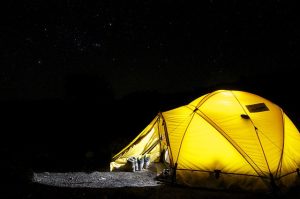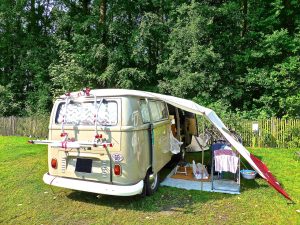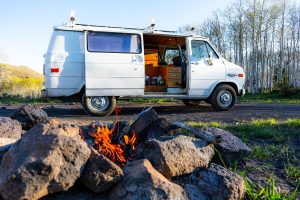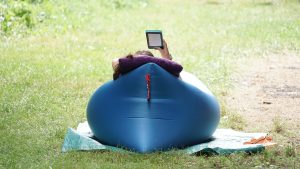Essential Tools For Family Camping
 When camping with a family, it’s important to bring the right tools and equipment to ensure a safe, comfortable, and enjoyable experience. Here are some essential tools to consider for family camping:
When camping with a family, it’s important to bring the right tools and equipment to ensure a safe, comfortable, and enjoyable experience. Here are some essential tools to consider for family camping:
- Tent: A sturdy and spacious tent is essential for providing shelter and protection from the elements. Make sure to choose a tent that is appropriate for the number of people in your family and the conditions you’ll be camping in.
- Sleeping Bags and Pads: Sleeping bags and pads provide insulation and cushioning for a comfortable night’s sleep. Consider the temperature rating and size of the bags and pads to ensure they are appropriate for your family’s needs.
- Stove: A portable stove is essential for cooking meals while camping. Consider a stove that is easy to set up and use, and that is appropriate for the size of your family and the conditions you’ll be camping in.
- Cooler: A cooler is necessary for keeping food and drinks cold while camping. Consider a cooler that is large enough to store food and drinks for your family, and that is durable enough to withstand the rigors of camping.
- First-aid Kit: A comprehensive first-aid kit is essential for treating minor injuries and illnesses while camping. Make sure to include bandages, antiseptic wipes, pain relievers, and any other items that your family might need.
- Flashlights or Headlamps: Flashlights or headlamps are essential for providing light after dark and for navigating the campground at night. Make sure to bring enough for each member of your family.
- Multi-tool: A multi-tool is a versatile tool that can be used for a variety of tasks, such as cutting rope, opening cans, and tightening screws.
- Trash Bags: Trash bags are essential for keeping your campsite clean and preventing litter from accumulating. Make sure to bring enough bags to last the duration of your trip.
By bringing these essential tools and equipment, you can ensure that your family camping trip is safe, comfortable, and enjoyable.
Family Tents
Family tents often come in a variety of sizes, with options for families of different sizes, and usually include features such as large windows, mesh roof vents, and rainflies to provide good ventilation and protect from the elements. They may also have additional features like electrical cord access, storage pockets, and easy-to-pitch designs for added convenience.
Family tents are an excellent option for families who enjoy camping and spending time outdoors, as they provide a comfortable and convenient way for families to enjoy the great outdoors together.
This article contains affiliate links
Budget Family Tent
When it comes to finding the best budget family tent, there are several options to choose from. Here are a few tents that are highly rated by customers and affordable:
- Coleman Steel Creek Fast Pitch Dome Tent: This tent is a good choice for families of up to six people, with a spacious interior and easy-to-pitch design.
- CORE 9 Person Instant Cabin Tent: This tent is perfect for families who need more space, as it can comfortably fit up to 9 people. It’s also quick and easy to set up, with an instant frame design.
- Ozark WT172115 Trail 10-Person Family Tent: Another option for large families, this tent can fit up to 10 people and has several built-in features such as electrical cord access and multiple windows for ventilation.
- Wenzel Pinyon 10 Person Modified Dome Camping Tent: This tent is a great choice for families who enjoy camping in various weather conditions, as it features a waterproof rainfly and strong frame.
- UNP Camping Tent 10-Person-Family Tents: This tent is a budget-friendly option for families of up to 10 people,easy up.secure and windproof.
Remember, it’s always a good idea to read reviews and compare the specifications of a few different tents before making a purchase, to ensure that you get the best value for your money.
Most Important Features For Family Tents
- Size and capacity: Make sure to choose a tent that is large enough to accommodate the number of people in your family and any gear you plan to bring.
- Space and layout: Consider the layout of the tent, as well as the amount of headroom and living space it provides, to ensure that everyone is comfortable inside. Some family tents feature separate sleeping areas for added privacy.
- Ventilation: Good ventilation is essential for a comfortable camping experience, especially in hot weather. Look for tents with large windows and mesh roof vents to allow for plenty of fresh air.
- Durability and waterproofing: A tent should be made of durable, high-quality materials and should have a waterproof rainfly to protect against inclement weather.
- Ease of setup: Family tents should be quick and easy to set up, so you can spend more time enjoying your camping trip and less time struggling with the tent.
- Additional features: Other useful features to look for in a family tent include electrical cord access, multiple storage pockets, and gear lofts for convenient organization.
- Price: Family tents can range in price from budget-friendly options to more expensive models with more features. Determine your budget and look for a tent that offers the best combination of features and value for your money.
Colder Weather Features Needed For Family Tents
- Insulation: Look for tents with built-in insulation or the ability to add a sleeping pad for added warmth.
- Sturdy construction: A tent should have a sturdy frame and be made of high-quality, weather-resistant materials to keep the elements out.
- Winter-ready features: Features such as full-coverage rainflies, reinforced tent corners, and snow flaps can help to protect against cold winds and snow.
- Ventilation: While good ventilation is important in any tent, it’s especially important in colder weather to avoid condensation buildup inside the tent. Look for tents with adjustable ventilation options to control the airflow.
- Accessibility: Consider the ease of accessing the tent, especially in inclement weather. Look for tents with large doors and vestibules, or add-on vestibules for extra storage space.
- Footprint: A tent footprint, which is a separate piece of material placed under the tent, can help to keep the tent dry and protect it from the cold ground.
- Space and layout: Make sure to choose a tent that provides enough space for everyone to sleep comfortably, and consider the layout to ensure that everyone has access to the door and vestibules.
When camping in colder weather, it’s also important to have a good quality sleeping bag, pad, and other gear to stay warm and comfortable.
Best Budget Cold Weather Sleeping Bags
- TETON Sports Tracker Ultralight Mummy Sleeping Bag: This sleeping bag is lightweight and compact, making it ideal for backpacking or camping. It’s also well-insulated, with 3 different temperature ratings.
- Coleman Sleeping Bag | 30°F Big and Tall Sleeping Bag : This sleeping bag is designed for cold weather conditions, with a temperature rating of 30°F. It’s also spacious and designed for big and tall people.
- KingCamp Ultralight Cold Weather Sleeping Bag for Adults & Kids : This sleeping bag is made with a waterproof and tear-resistant outer layer, making it a durable option for cold weather camping. It also has a temperature rating of 32°F.
- ALPS Mountaineering Crescent Lake 0-Degree Sleeping Bag: This sleeping bag is designed for extremely cold temperatures, with a temperature rating of 0°F. It’s also spacious and has a draft collar to keep out cold air.
- 0 Degree Winter Sleeping Bags for Adults Camping: This sleeping bag is a budget-friendly option for cold weather camping, with a temperature rating of 5 – 32°F. It’s also made with a waterproof and tear-resistant outer layer for added durability.
Remember, when choosing a sleeping bag for cold weather, it’s important to consider the temperature rating and choose one that is appropriate for the conditions you’ll be camping in. Also, make sure to consider the size and weight of the sleeping bag, as well as any other features such as a draft collar or hood, to ensure that it meets your needs and provides a comfortable camping experience.
Features To Look For In Summer Sleeping Bags
- Temperature Rating: Summer sleeping bags typically have a temperature rating of between 30°F and 50°F. Make sure to choose a bag that is appropriate for the conditions you’ll be camping in.
- Size and Weight: Summer sleeping bags are designed to be lightweight and compact, making them ideal for backpacking and camping. Consider the size and weight of the bag to ensure that it’s easy to carry and pack.
- Shape: Summer sleeping bags come in different shapes, including mummy, rectangular, and semi-rectangular. Mummy bags are more thermally efficient and provide a snug fit, but may feel restrictive. Rectangular and semi-rectangular bags are more spacious and provide more room to move around, but may not be as thermally efficient.
- Ventilation: Summer sleeping bags are designed to be breathable and allow for good airflow to prevent overheating. Look for bags with vents, zippers, or other features that allow for ventilation.
- Material: Summer sleeping bags are typically made with lightweight and breathable materials, such as nylon or polyester. Consider the material to ensure that the bag is comfortable and breathable.
- Compression: Summer sleeping bags can be compressed for easy storage and transportation. Look for bags with compression straps or stuff sacks to help reduce the size and weight of the bag.
By considering these features, you can choose a summer sleeping bag that is comfortable, lightweight, and appropriate for the conditions you’ll be camping in.
Camping Sleeping Pad
Camping sleeping pads serve several important functions. Firstly, they provide insulation and help to prevent heat loss to the ground, which is especially important in cold weather. Secondly, they provide cushioning, making the ground feel more comfortable to sleep on. And finally, sleeping pads can help to absorb impact and reduce the risk of injury if the sleeper moves around during the night.
When choosing a camping sleeping pad, consider factors such as the insulation (R-value), size, weight, and durability to ensure that it meets your needs and provides a comfortable camping experience.
Best Camping Sleeping Pads
- Therm-a-Rest NeoAir Xlite: This lightweight and compact sleeping pad is a popular choice for backpacking and camping, with an R-value of 3.2 and a comfortable, cushioned feel.
- Klymit Static V2: This budget-friendly sleeping pad is well-insulated, with an R-value of 1.3, and features a unique v-chamber design for stability and comfort.
- Big Agnes Q-Core SLX: This sleeping pad is designed for a comfortable night’s sleep, with a plush, cushioned feel and an R-value of 4.5. It also features a unique quilted design for added comfort.
- Exped MegaMat Max: This sleeping pad is designed for ultimate comfort, with a plush feel and an R-value of 9.5. It’s also durable and easy to inflate, making it a great choice for car camping.
- Sea to Summit Comfort Light Insulated: This sleeping pad is lightweight and compact, making it ideal for backpacking. It also features an R-value of 3.3 and a unique egg-carton design for added comfort.
When choosing a sleeping pad, consider the insulation (R-value), size, weight, and durability to ensure that it meets your needs and provides a comfortable camping experience.
Bivvy Bags For Family Camping
While bivvy bags can be used for family camping, they are typically designed for solo use and may not be the best option for families, as they can be cramped and confining. However, there are some larger bivvy bags available that can accommodate two people, if you’re looking for a compact shelter option for family camping.
When choosing a bivvy bag for family camping, consider factors such as the size, weight, and breathability of the bag, as well as the durability and waterproofing of the materials. It’s also important to consider the conditions you’ll be camping in and the level of protection you’ll need from the elements.
In general, bivvy bags are a lightweight and compact shelter option for camping, but they may not be the most comfortable or practical option for families. Consider your specific needs and conditions before making a decision.
 Whether you’re interested in exploring the backwoods, hiking the mountains, or enjoying the beach, living in a van is a great way to do it. But, for many people, this lifestyle can be a scary one. Whether you’re new to it or a veteran, there are some things to consider.
Whether you’re interested in exploring the backwoods, hiking the mountains, or enjoying the beach, living in a van is a great way to do it. But, for many people, this lifestyle can be a scary one. Whether you’re new to it or a veteran, there are some things to consider.
 Comfy Camping
Comfy Camping